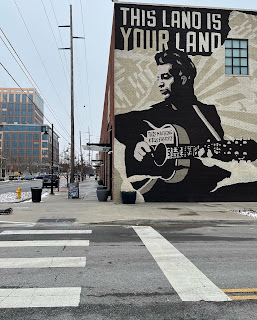Lake Dardanelle State Park
Russellville, AR
In 1838 over 16,000 Native Americans were forcibly removed from their homes and lands and marched 1600 miles to Oklahoma for “re-settlement”. Indian removal was a priority for President Andrew Jackson and along this “Trail of Tears” many perished. It was not the first, or the last, indignity that white people have perpetrated upon people of color.
Beginning with our visit to the Legacy Museum and our drive over the Edmund Pettus Bridge in Selma, AL we have felt the tugs of history all around us. Those tugs are not pretty….. but we must acknowledge the past and face it head on.
I had planned some of our stops on this southern route but I did not see them as “thematic” in any way….just places I wanted to see. However, as we continued our drive west along Route 40 from Tulsa, Tim asked if we were actually on our own “trail of tears”. Maybe the political backdrop, the cultural reckoning……played into my choices… not sure. But here we are. And we are learning something new at every stop.
We left Fayetteville, AR the day after a snow/ice storm. In these parts there are no plows so everyone just settles in and waits. Actually, kind of a wonderful response…. Slow down, take it easy, no rush.
We had planned a stop in Tulsa, OK to visit the Woody Guthrie Center. Opened in 2013, this museum and research center is located in the arts district of downtown Tulsa. - vibrant and very interesting area.
Woody Guthrie Center
Tulsa, OK
We all know (some of) Woody Guthrie’s music and the influence he had on so many folk artists that followed but I did not know that he was also an artist, that his father was a member of the KKK, that he was under surveillance by the FBI, that he died at 55 from complications from Huntington’s disease, and…. that at one point he lived in housing managed by Fred Trump!
“Oh the tangled webs we weave….”
Beech House Ain’t My Home
Woody Guthrie wrote over 3,000 songs in this lifetime - although only a few were recorded. He sang/spoke to the disenfranchised and was a committed activist.
Let’s all be more like Woody.
We then made our way down the street a few blocks and visited Greenwood Rising. Opened in August of 2021, this museum and history center is located at the corner of Greenwood Ave and Archer St - the center of Tulsa’s historic Black district. It is also the district that once was called “Black Wall Street” because it was the home of a thriving and successful Black community that put down roots after the Civil War and continued to prosper into the 20th century.
In 1921 the entire area was burned to the ground by their (across the tracks) white neighbors. The Tulsa Race Massacre was not acknowledged for many years, it was not taught.
The Greenwood Rising commission had its birth in 2015 with the goal of establishing this center and legacy on its 100 year anniversary. It accomplished that goal and continues in their efforts to revitalize this area, speak the truth, and foster local entrepreneurship.
It is working.
We drove west out of Tulsa and truthfully, in my mind, there is no real reason to stop until one enters New Mexico. Sorry, but I speak my truth. The rolling hills of Oklahoma slowly become flattened as one crosses the Texas panhandle. From there it is flat…. Flat…..flat until approximately 20 miles from the New Mexico border and the hills reappear and slowly rise to become mesas (hills with their tops cut off!).
It is a spectacular moment. And for some reason, at least for me, the sky just gets much bigger than it had been.
In the high desert of New Mexico it is currently 39 degrees. But with that big sky and a full sun a sweatshirt is all I need.
Tucumcari, NM





An important journey.
ReplyDelete